Plant-based Seafood Market Research, 2031
The global plant-based seafood market size was valued at $42.1 million in 2021, and is projected to reach $1.3 billion by 2031, growing at a CAGR of 42.3% from 2022 to 2031.
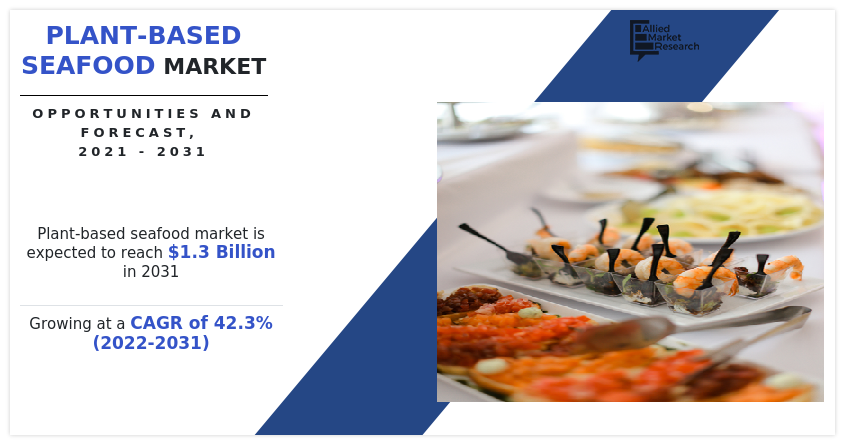
The plant-based seafood market is segmented into Distribution Channel, Consumer, Product and Source.
Plant-based are manufactured using various plant proteins such as fruits, vegetables, legumes, algae, and seaweed and are found in the form of tuna, cod, salmon, shrimps, and crabs. The plant-based seafood is also called alternative seafood. The growth of the global plant-based seafood market is attributed to various factors such as the depletion of natural ocean resources, the rise in global population, the increase in pressure on the global food supply chain, the surge in the prevalence of zoonotic diseases among humans, rise in vegan population, and increase in awareness regarding animal welfare and animal cruelty in farms.
Vegan has emerged as a trend due to the increase in awareness regarding animal cruelty. This trend has led to a corresponding increase in the amount of money that people are willing to spend on the purchase of vegan products. According to a survey commissioned by the Vegan Society, the number of vegans in the UK quadrupled between 2014 and 2018. In 2019, there were 6,00,000 vegans, around 1.16% of the population. Veganism was first coined in the UK. Such an increase in the vegan population has led to a rise in the demand for plant-based seafood. As per the survey commissioned by the government of the UK, Britain’s vegans are pretty new to the lifestyle, with 63% having started out only in the last five years. It is estimated that around one percent of the global population is vegan and this number is expected to rise significantly in the foreseeable future. Therefore, a significant rise in the vegan population across the globe is expected to drive the growth of the plant-based seafood market growth during the forecast period.
Moreover, the depletion of natural seafood resources is a major factor behind the rise in the importance of plant-based seafood. Overfishing and exploitation of natural fish stock in oceans led to the extinction of around 90% of the fish species. According to the report of the Food and Agriculture Organization of the United Nations, in 2020, global capture fisheries production was 90.3 million tons – a fall of 4.0% compared with the average over the previous three years. According to the blog of New Security Beat, nearly 90% of the world’s fish stocks are fully exploited or overexploited, and some scientists estimate that in 30 years there may be little or no seafood available. Such depletion of natural food resources will lead to the shift of consumers toward plant-based alternatives which will drive the market growth for plant-based seafood products.
As per plant-based seafood market analysis, the market is segmented on the basis of product, source, distribution channel, consumer, and region. On the basis of product, the market is divided into fish products, prawn and shrimp products, and crab products. The fish products segment is further bifurcated into burger patty, fillets, chunks and tips, cutlets, tenders and fingers, and others. By source, it is categorized into soy, wheat, pea, canola, lentil, and others. Depending on the distribution channel, the market is segmented into supermarkets and hypermarkets, specialty stores, HoReCa, Convenience Stores, and online sales. On the basis of consumer, it is divided into omnivore, flexitarian, vegetarian, and vegan. Region-wise, it is analyzed across North America, Europe, Asia-Pacific, and LAMEA (Latin America, Middle East, and Africa).
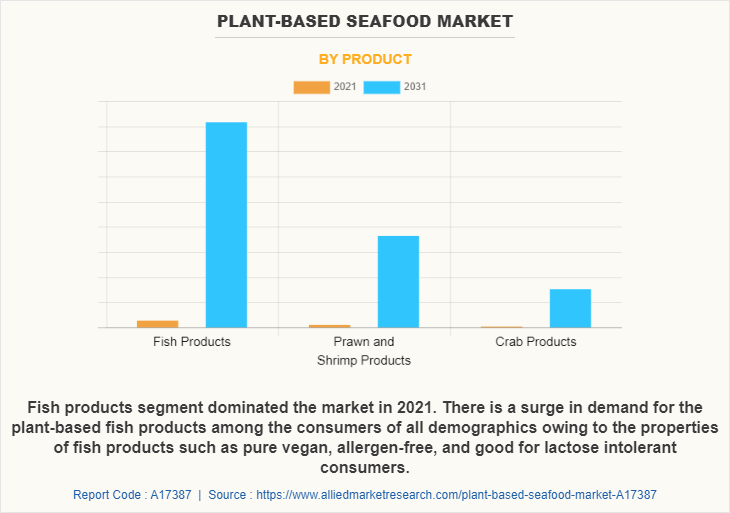
As per the plant-based seafood market forecast, depending on the product, the fish products segment is expected to remain dominant during the forecast period. The fish products segment accounted for 62.7% of the plant-based seafood market share in 2021. The huge demand for various fish products like burger patties, fillets, cutlets, and tenders has led to the rapid growth of this segment. Further, the easy availability of fish products through HoReCa and supermarkets has led to the dominance of this segment in the market.
The growing awareness regarding the health benefits of consuming plant-based protein, the welfare of animals, and rising concerns over the environment and sustainability are the key factors that are boosting the growth of the market across the globe. Moreover, the rising cases of food sensitivity across the globe are significantly supplementing the growth of this segment. Plant-based fish products are allergen-free, purely vegan, mercury-free, and free from side effects coupled with longer shelf-life, which is expected to fuel the growth of the fish-products segment in the global plant-based seafood market during the forecast period.
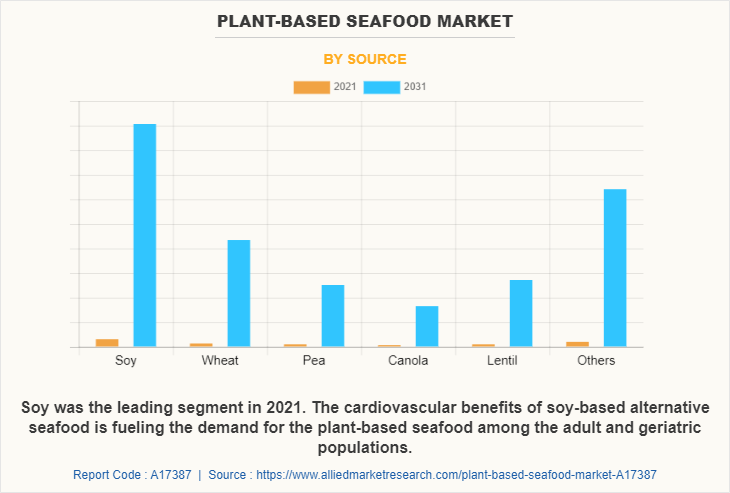
According to the plant-based seafood market trends, based on source, wheat is expected to be the fastest-growing segment during the forecast period. Wheat protein is used to manufacture various plant-based fish such as tuna, cod, salmon, fish fingers, and baked fish. Generally, these products are made flavor neutral so that the desired and specific flavor can be added later. The surge in global population and rising pressure on the global food supply chain coupled with the depleting fish stocks in oceans has resulted in the development of plant-based seafood, which is expected to gain rapid momentum in the forthcoming years thereby driving the growth of the wheat segment in the global plant-based seafood industry.
On the other hand, the soy segment dominated the market with 36.3% in 2021. Soy is a rich source of protein that is used to replace animal protein in an individual’s regular diet. Soybean has low saturated fat and contains no cholesterol Soybeans contains all eight essential amino acids such as threonine, phenylalanine, valine, methionine, leucine, lysine, isoleucine, and tryptophan. Soybeans are also a rich source of calcium, zinc, fiber, iron, and vitamin B which makes it an idle choice for making plant-based seafood and is expected to boost the plant-based seafood market demand in the forthcoming years.
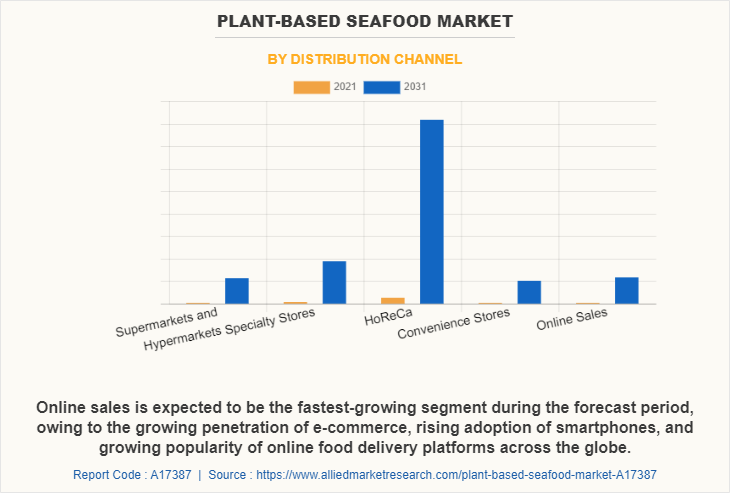
According to the plant-based seafood market opportunity, depending on the distribution channel, online sales is expected to witness the highest CAGR of 44.7% during the forecast period. The online platform serves as a popular medium for the purchase of packaged food like plant-based seafood. This is attributed to easy availability and the benefits such as information about the attributes of the products, time-saving features, and the facility of home delivery provided by the online platform. In addition, consumers prefer to buy products online since it is convenient and offers a large selection of brands that are not available in retail. Moreover, the online sales channel has increased consumer reach owing to which it has evolved as a key source of revenue for many plant-based seafood companies. Consumers are becoming more aware of the many purchase patterns that exist in society as technology advances and internet services become more widely available. The technology attracts millennials and generation Z and is expected to influence the buying pattern of products. According to the United Nations Conference on Trade and Development (UNCTAD), the e-commerce sector's proportion of total retail sales increased from 16% to 19% in 2020. Furthermore, online sales are expected to grow notably shortly, due to the rapid increase in mobile users. An increase in e-commerce sales, improvements in logistics services, and ease in payment options further boost the growth of the global plant-based seafood market.
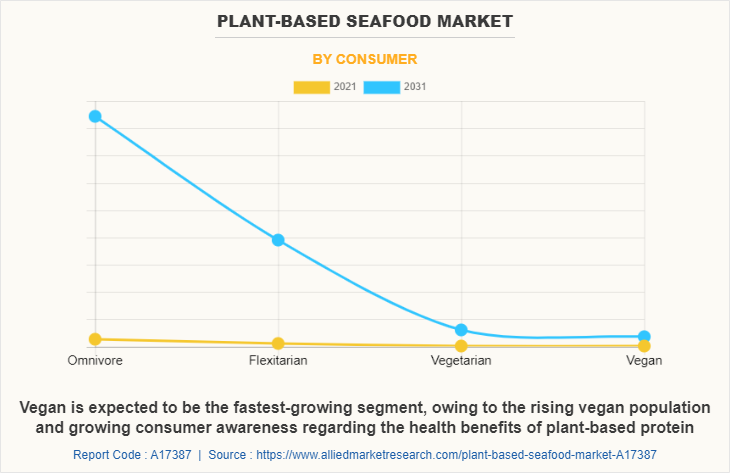
Based on consumer, the omnivore segment accounted for the largest revenue share in 2021. Humans are omnivores, therefore some nutritional needs are typically better met by plant sources, while others are typically better met by eating animal products. For instance, plant-based foods are significantly more capable of satisfying human diet needs for magnesium and vitamin C as compared to animal-based foods. Furthermore, plant-based diets frequently contain higher amounts of folate, manganese, thiamin, potassium, and vitamin E. Rising awareness of zoonotic diseases will lead to the shift of omnivores to plant-based diets. This rising awareness about the risk of gastrointestinal cancer due to fish consumption is also a reason for the shift of the omnivore population to a plant-based diet.
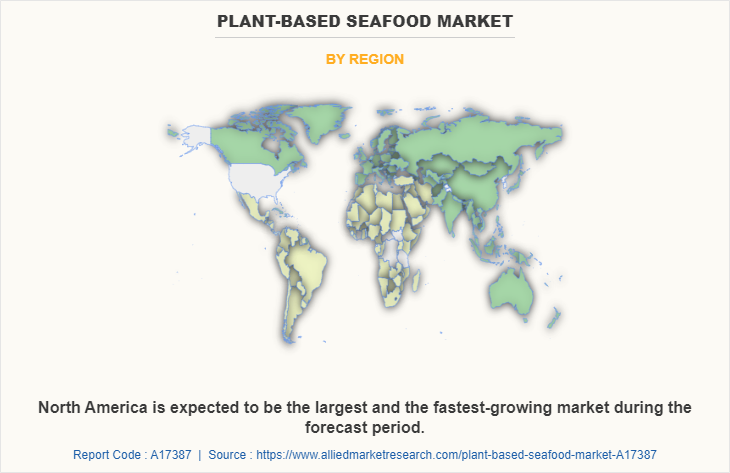
Region-wise, Europe was the largest plant-based seafood market, owing to the rapidly rising demand for plant-based food in major European economies. According to the European Union (Europa.eu), there has been a huge growth in sales of plant-based meat and fish in Europe in the past two years, with the largest growth being recorded in Germany which grew by 226%, followed by Austria with a growth of 82%. Romania plant-based meat and fish sales grew by 154% while sales in France grew by 100% in the past two years.
Germany was the leading consumer of plant-based seafood accounting for 14.6% of the market share in 2021, followed by the UK with 11.0% and France with 9.8%. There is a rise of 49% in retail sales of plant-based foods across Europe in comparison to 2018 in 2020 as per GFI. The rapid increase in demand for seafood alternatives in the UK, Germany, France, and others will result in the growth of the market. Companies in the region are likely to launch more alternatives for fish. For example, Hooked, a startup, has claimed that the world’s first plant-based shredded salmon is being developed by it.
Asia-Pacific is the home to 60% of the global population with a majority of the population being young. The presence of a huge youth population, rising employment, rising disposable income, rapid urbanization, changing food habits of the consumers, rising number of product launches, and changes in government policy are the major factors that are expected to drive the growth of the Asia-Pacific plant-based seafood market during the forecast period.
The major players operating in the global plant-based seafood industry include Puris, Ingredion GmbH, Morning Star Farms, Sotexpro, Tyson Food, Inc., Glanbia Plc, Ocean Hugger Foods, Good Catch Foods, Impossible Foods, Inc., New Wave Foods, Sophie's Kitchen, Inc., Gardein, Quorn (Monde Nissin Corporation) SoFine Foods, and Tofuna Fysh. These market players are constantly engaged in various developmental strategies such as acquisitions, mergers, and product launches to exploit plant-based seafood market opportunities and gain market share.
Key Benefits For Stakeholders
- This report provides a quantitative analysis of the plant-based seafood market size, market segments, current trends, estimations, and dynamics of the plant-based seafood market analysis from 2021 to 2031 to identify the prevailing plant-based seafood market opportunities.
- The market research is offered along with information related to key drivers, restraints, and opportunities.
- Porter's five forces analysis highlights the potency of buyers and suppliers to enable stakeholders make profit-oriented business decisions and strengthen their supplier-buyer network.
- In-depth analysis of the plant-based seafood market segmentation assists to determine the prevailing market opportunities.
- Major countries in each region are mapped according to their revenue contribution to the global market.
- Market player positioning facilitates benchmarking and provides a clear understanding of the present position of the market players.
- The report includes the analysis of the regional as well as global plant-based seafood market trends, key players, market segments, application areas, and market growth strategies.
Plant-based Seafood Market Report Highlights
| Aspects | Details |
| Market Size By 2031 | USD 1.3 billion |
| Growth Rate | CAGR of 42.3% |
| Forecast period | 2021 - 2031 |
| Report Pages | 300 |
| By Distribution Channel |
|
| By Consumer |
|
| By Product |
|
| By Source |
|
| By Region |
|
| Key Market Players | Glanbia Plc, Ocean Hugger Foods, good catch foods, Impossible Foods Inc., PURIS, Tyson Foods, Inc., MorningStar Farms, Sotexpro, Ahimsa Foods, Sophie's Kitchen, Inc., sofine foods, Tofuna Fysh, gardeinâ„¢, Ingredion GmbH, New Wave Foods |
Analyst Review
Based on the insights from the top CXOs, around 54% of the consumers in Germany, the U.S., and the UK have tried plant-based protein. Around 47% of them consume plant-based protein at least once a week. The significantly growing demand for plant-based seafood in Asia-Pacific is expected to have a positive impact on the global market. The presence of a huge population coupled with the rising government initiatives to promote the consumption of plant-based food in major economies like China, Japan, and Australia is fueling the overall sales of plant-based seafood. Moreover, the rise in cases of zoonotic diseases such as COVID-19, H1N1 flu, and monkeypox among humans is further encouraging consumers to opt for plant-based meat and seafood, which will provide a significant impetus to the global plant-based seafood industry in the forthcoming years.
The CXOs further added that significantly growing investments in plant-based food companies across the globe is expected to accelerate the plant-based seafood market growth in the upcoming future. A capital of around $6.4 billion had been invested from 1980 to 2021. In 2021, around $2 billion was invested that accounted for 30% of the total investment in plant-based food companies that was made between 1980 and 2021. Therefore, the investors’ confidence regarding the future growth prospects and opportunities are showing a clear positive indication towards the significant growth of the plant-based seafood market.
The global plant-based seafood market size was valued at $42.1 million in 2021, and is estimated to reach $1,333.5 million by 2031, registering a CAGR of 42.3% from 2022 to 2031. The growth of the global plant-based seafood market is attributed to various factors such as depletion of natural ocean resources, rise in global population, increase in pressure of global food supply chain, surge in prevalence of zoonotic diseases among humans, rise in vegan population, and increase in awareness regarding animal welfare and animal cruelty in farms.
The plant-based seafood market report is available on request on the website of Allied Market Research.
The forecast period considered in the global plant-based seafood market report is from 2022 to 2031. The report analyzes the market sizes from 2022 to 2031 along with the upcoming market trends and opportunities. The report also covers the key strategies adopted by the key players operating in the market.
The major players operating in the global plant-based seafood industry includes Puris, Ingredion GmbH, Morning Star Farms, Sotexpro, Tyson Food, Inc., Glanbia Plc, Ocean Hugger Foods, Good Catch Foods, Impossible Foods, Inc., New Wave Foods, Sophie's Kitchen, Inc., Gardein, Quorn (Monde Nissin Corporation) SoFine Foods, and Tofuna Fysh.
As per plant-based seafood market analysis, the market is segmented on the basis of product, source, distribution channel, consumer, and region. On the basis of product, the market is divided into fish products, prawn and shrimp products, and crab products. The fish products segment is further bifurcated into burger patty, fillets, chunks and tips, cutlet, tenders and fingers, and others. By source, it is categorized into soy, wheat, pea, canola, lentil, and others. Depending on distribution channel, the market is segmented into supermarkets and hypermarkets, specialty stores, HoReCa, convenience Stores, and online sales. On the basis of consumer, it is divided into omnivore, flexitarian, vegetarian, and vegan. Region wise, it is analyzed across North America, Europe, Asia-Pacific, and LAMEA (Latin America, Middle East, and Africa).
Asia-Pacific is the home to 60% of the global population with a majority of the population being young. The presence of a huge youth population, rising employment, rising disposable income, rapid urbanization, changing food habits of the consumers, rising number of product launches and changes in government policy are the major factors that are expected to drive the growth of the Asia-Pacific plant-based seafood market during the forecast period.
Europe was the largest plant-based seafood market, owing to the rapidly rising demand for the plant-based food in major European economies. According to the European Union (Europa.eu), there has been a huge growth in sales of plant-based meat and fish in Europe in the past two years, with largest growth being recorded in Germany that grew by 226%, followed by Austria with a growth of 82%. Romania plant-based meat and fish sales grew by 154% while sales in France grew by 100% in the past two years.
The COVID-19 pandemic disrupted food & beverage supply chains all across the globe. Consumption habits of consumers have changed by the perception of the risk associated with COVID-19. Consumers' fear of potential food and beverage shortages has fueled the hoarding trend.
Loading Table Of Content...


